Bob's Claim Against CP Ltd: A Study of Contractual and Vicarious Liability
VerifiedAdded on 2019/12/03
|11
|3586
|161
Report
AI Summary
This assignment report focuses on the contractual liabilities of a contract, specifically on the types of injuries that can occur on hand and arm, as well as contractual negligence. The report analyzes various elements that affect the legality of a contract, including vicarious liability, tort liability, and breach of duty. It also examines a case study involving CP Ltd, an employee named Bob, and another incident where Jason, an employee of CP Ltd, crossed the speed limit to meet delivery deadlines. The report concludes that CP Ltd is not liable for damages caused by Bob's injuries due to contractual negligence, and similarly, CP Ltd is not liable for damages caused to a shop by Jason's actions since they did not occur on the basis of rights and authorities of employees.
Contribute Materials
Your contribution can guide someone’s learning journey. Share your
documents today.
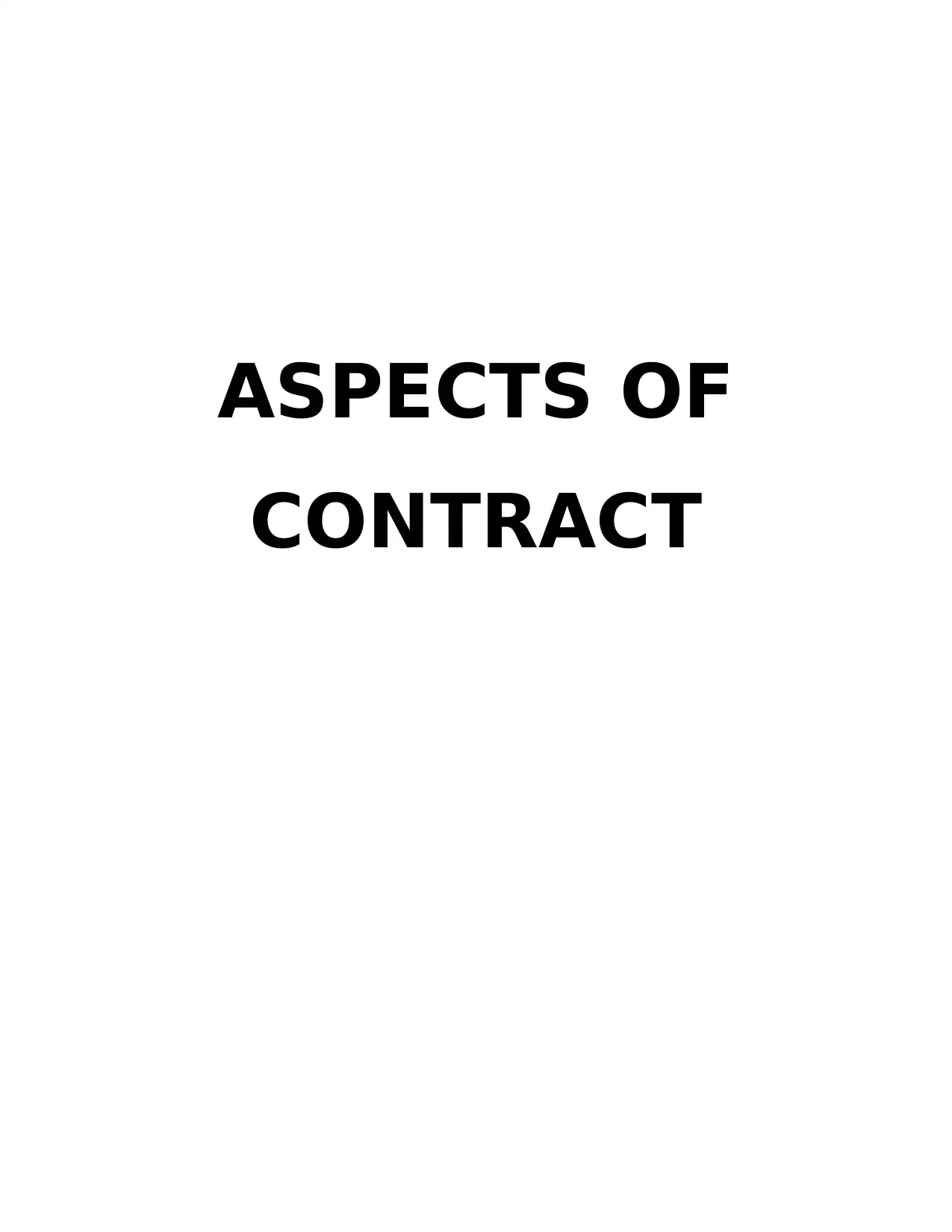
ASPECTS OF
CONTRACT
CONTRACT
Secure Best Marks with AI Grader
Need help grading? Try our AI Grader for instant feedback on your assignments.

Table of Contents
INTRODUCTION ..........................................................................................................................1
SCENARIO 1...................................................................................................................................1
1..............................................................................................................................................1
2..............................................................................................................................................2
3..............................................................................................................................................2
4. ............................................................................................................................................3
5. ............................................................................................................................................5
SCENARIO 2...................................................................................................................................5
1..............................................................................................................................................5
2..............................................................................................................................................6
3..............................................................................................................................................6
4..............................................................................................................................................6
5..............................................................................................................................................7
6..............................................................................................................................................7
CONCLUSION................................................................................................................................7
REFERENCES................................................................................................................................8
INTRODUCTION ..........................................................................................................................1
SCENARIO 1...................................................................................................................................1
1..............................................................................................................................................1
2..............................................................................................................................................2
3..............................................................................................................................................2
4. ............................................................................................................................................3
5. ............................................................................................................................................5
SCENARIO 2...................................................................................................................................5
1..............................................................................................................................................5
2..............................................................................................................................................6
3..............................................................................................................................................6
4..............................................................................................................................................6
5..............................................................................................................................................7
6..............................................................................................................................................7
CONCLUSION................................................................................................................................7
REFERENCES................................................................................................................................8
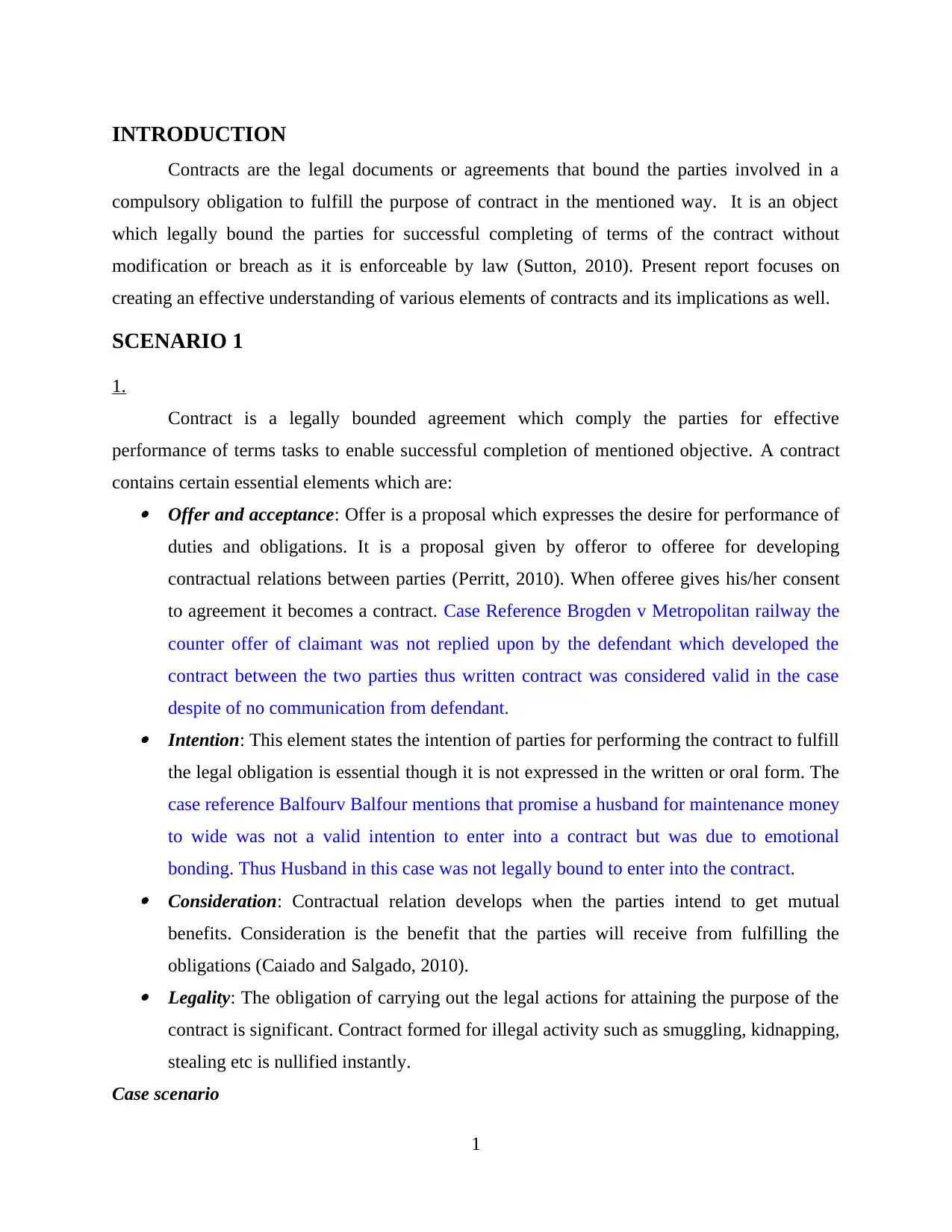
INTRODUCTION
Contracts are the legal documents or agreements that bound the parties involved in a
compulsory obligation to fulfill the purpose of contract in the mentioned way. It is an object
which legally bound the parties for successful completing of terms of the contract without
modification or breach as it is enforceable by law (Sutton, 2010). Present report focuses on
creating an effective understanding of various elements of contracts and its implications as well.
SCENARIO 1
1.
Contract is a legally bounded agreement which comply the parties for effective
performance of terms tasks to enable successful completion of mentioned objective. A contract
contains certain essential elements which are: Offer and acceptance: Offer is a proposal which expresses the desire for performance of
duties and obligations. It is a proposal given by offeror to offeree for developing
contractual relations between parties (Perritt, 2010). When offeree gives his/her consent
to agreement it becomes a contract. Case Reference Brogden v Metropolitan railway the
counter offer of claimant was not replied upon by the defendant which developed the
contract between the two parties thus written contract was considered valid in the case
despite of no communication from defendant. Intention: This element states the intention of parties for performing the contract to fulfill
the legal obligation is essential though it is not expressed in the written or oral form. The
case reference Balfourv Balfour mentions that promise a husband for maintenance money
to wide was not a valid intention to enter into a contract but was due to emotional
bonding. Thus Husband in this case was not legally bound to enter into the contract. Consideration: Contractual relation develops when the parties intend to get mutual
benefits. Consideration is the benefit that the parties will receive from fulfilling the
obligations (Caiado and Salgado, 2010). Legality: The obligation of carrying out the legal actions for attaining the purpose of the
contract is significant. Contract formed for illegal activity such as smuggling, kidnapping,
stealing etc is nullified instantly.
Case scenario
1
Contracts are the legal documents or agreements that bound the parties involved in a
compulsory obligation to fulfill the purpose of contract in the mentioned way. It is an object
which legally bound the parties for successful completing of terms of the contract without
modification or breach as it is enforceable by law (Sutton, 2010). Present report focuses on
creating an effective understanding of various elements of contracts and its implications as well.
SCENARIO 1
1.
Contract is a legally bounded agreement which comply the parties for effective
performance of terms tasks to enable successful completion of mentioned objective. A contract
contains certain essential elements which are: Offer and acceptance: Offer is a proposal which expresses the desire for performance of
duties and obligations. It is a proposal given by offeror to offeree for developing
contractual relations between parties (Perritt, 2010). When offeree gives his/her consent
to agreement it becomes a contract. Case Reference Brogden v Metropolitan railway the
counter offer of claimant was not replied upon by the defendant which developed the
contract between the two parties thus written contract was considered valid in the case
despite of no communication from defendant. Intention: This element states the intention of parties for performing the contract to fulfill
the legal obligation is essential though it is not expressed in the written or oral form. The
case reference Balfourv Balfour mentions that promise a husband for maintenance money
to wide was not a valid intention to enter into a contract but was due to emotional
bonding. Thus Husband in this case was not legally bound to enter into the contract. Consideration: Contractual relation develops when the parties intend to get mutual
benefits. Consideration is the benefit that the parties will receive from fulfilling the
obligations (Caiado and Salgado, 2010). Legality: The obligation of carrying out the legal actions for attaining the purpose of the
contract is significant. Contract formed for illegal activity such as smuggling, kidnapping,
stealing etc is nullified instantly.
Case scenario
1
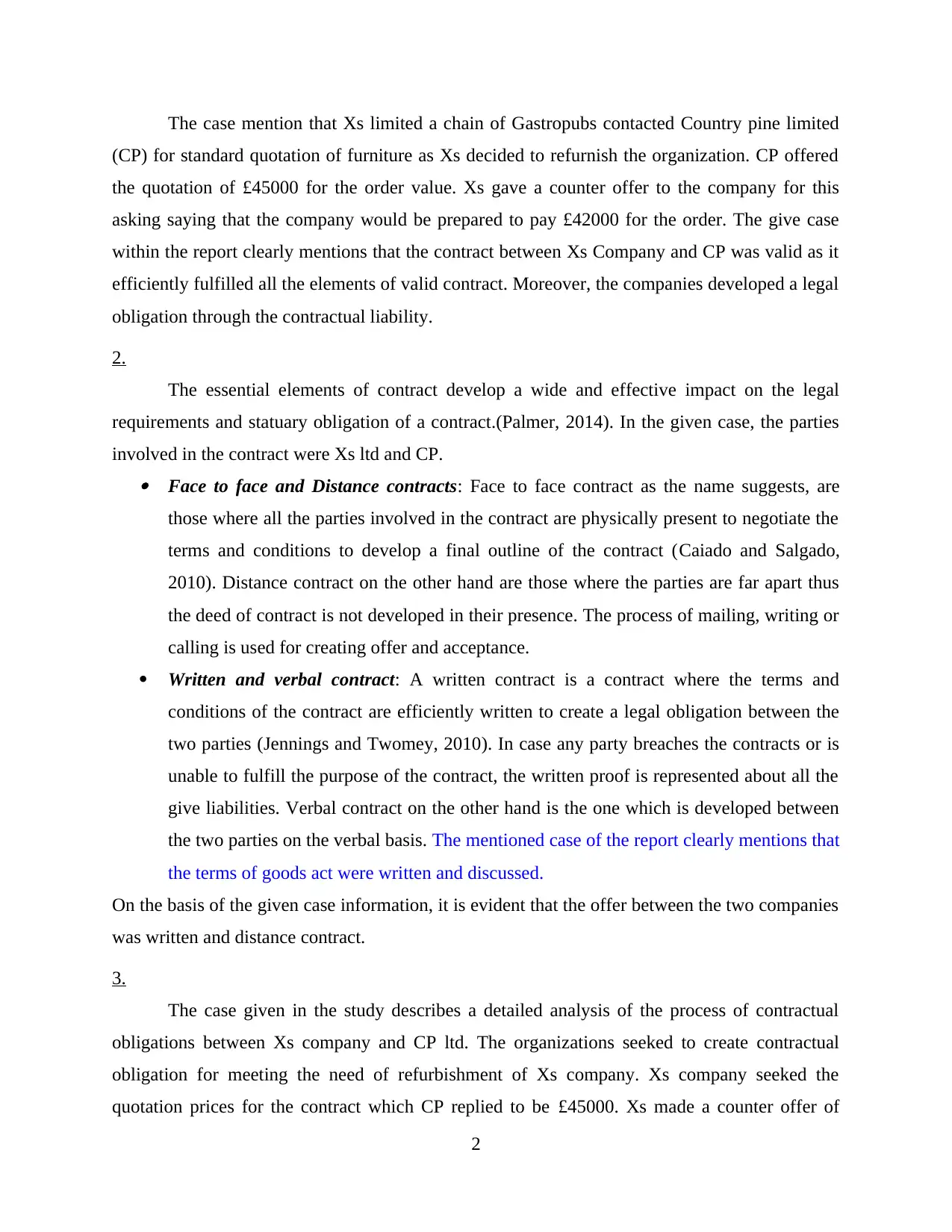
The case mention that Xs limited a chain of Gastropubs contacted Country pine limited
(CP) for standard quotation of furniture as Xs decided to refurnish the organization. CP offered
the quotation of £45000 for the order value. Xs gave a counter offer to the company for this
asking saying that the company would be prepared to pay £42000 for the order. The give case
within the report clearly mentions that the contract between Xs Company and CP was valid as it
efficiently fulfilled all the elements of valid contract. Moreover, the companies developed a legal
obligation through the contractual liability.
2.
The essential elements of contract develop a wide and effective impact on the legal
requirements and statuary obligation of a contract.(Palmer, 2014). In the given case, the parties
involved in the contract were Xs ltd and CP. Face to face and Distance contracts: Face to face contract as the name suggests, are
those where all the parties involved in the contract are physically present to negotiate the
terms and conditions to develop a final outline of the contract (Caiado and Salgado,
2010). Distance contract on the other hand are those where the parties are far apart thus
the deed of contract is not developed in their presence. The process of mailing, writing or
calling is used for creating offer and acceptance.
Written and verbal contract: A written contract is a contract where the terms and
conditions of the contract are efficiently written to create a legal obligation between the
two parties (Jennings and Twomey, 2010). In case any party breaches the contracts or is
unable to fulfill the purpose of the contract, the written proof is represented about all the
give liabilities. Verbal contract on the other hand is the one which is developed between
the two parties on the verbal basis. The mentioned case of the report clearly mentions that
the terms of goods act were written and discussed.
On the basis of the given case information, it is evident that the offer between the two companies
was written and distance contract.
3.
The case given in the study describes a detailed analysis of the process of contractual
obligations between Xs company and CP ltd. The organizations seeked to create contractual
obligation for meeting the need of refurbishment of Xs company. Xs company seeked the
quotation prices for the contract which CP replied to be £45000. Xs made a counter offer of
2
(CP) for standard quotation of furniture as Xs decided to refurnish the organization. CP offered
the quotation of £45000 for the order value. Xs gave a counter offer to the company for this
asking saying that the company would be prepared to pay £42000 for the order. The give case
within the report clearly mentions that the contract between Xs Company and CP was valid as it
efficiently fulfilled all the elements of valid contract. Moreover, the companies developed a legal
obligation through the contractual liability.
2.
The essential elements of contract develop a wide and effective impact on the legal
requirements and statuary obligation of a contract.(Palmer, 2014). In the given case, the parties
involved in the contract were Xs ltd and CP. Face to face and Distance contracts: Face to face contract as the name suggests, are
those where all the parties involved in the contract are physically present to negotiate the
terms and conditions to develop a final outline of the contract (Caiado and Salgado,
2010). Distance contract on the other hand are those where the parties are far apart thus
the deed of contract is not developed in their presence. The process of mailing, writing or
calling is used for creating offer and acceptance.
Written and verbal contract: A written contract is a contract where the terms and
conditions of the contract are efficiently written to create a legal obligation between the
two parties (Jennings and Twomey, 2010). In case any party breaches the contracts or is
unable to fulfill the purpose of the contract, the written proof is represented about all the
give liabilities. Verbal contract on the other hand is the one which is developed between
the two parties on the verbal basis. The mentioned case of the report clearly mentions that
the terms of goods act were written and discussed.
On the basis of the given case information, it is evident that the offer between the two companies
was written and distance contract.
3.
The case given in the study describes a detailed analysis of the process of contractual
obligations between Xs company and CP ltd. The organizations seeked to create contractual
obligation for meeting the need of refurbishment of Xs company. Xs company seeked the
quotation prices for the contract which CP replied to be £45000. Xs made a counter offer of
2
Secure Best Marks with AI Grader
Need help grading? Try our AI Grader for instant feedback on your assignments.
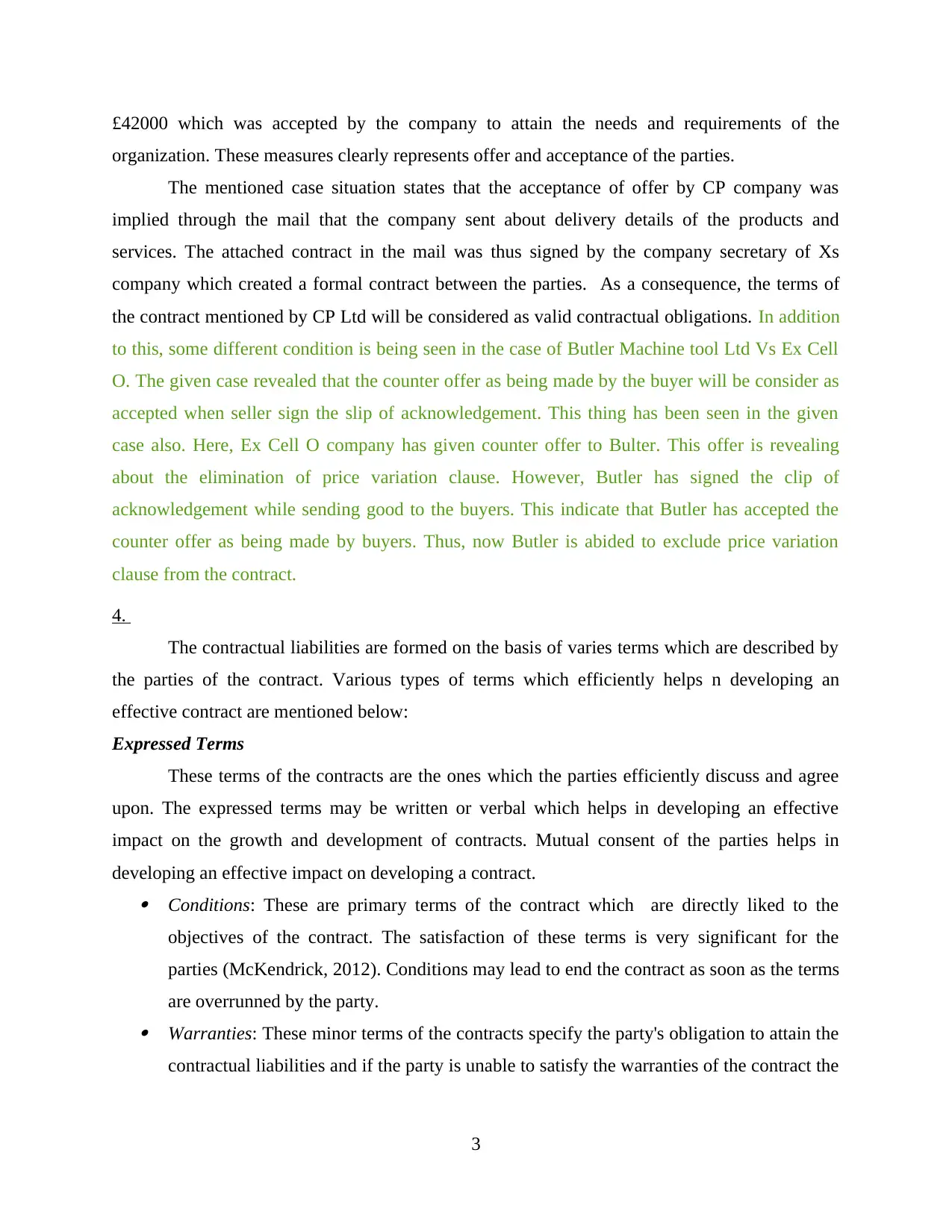
£42000 which was accepted by the company to attain the needs and requirements of the
organization. These measures clearly represents offer and acceptance of the parties.
The mentioned case situation states that the acceptance of offer by CP company was
implied through the mail that the company sent about delivery details of the products and
services. The attached contract in the mail was thus signed by the company secretary of Xs
company which created a formal contract between the parties. As a consequence, the terms of
the contract mentioned by CP Ltd will be considered as valid contractual obligations. In addition
to this, some different condition is being seen in the case of Butler Machine tool Ltd Vs Ex Cell
O. The given case revealed that the counter offer as being made by the buyer will be consider as
accepted when seller sign the slip of acknowledgement. This thing has been seen in the given
case also. Here, Ex Cell O company has given counter offer to Bulter. This offer is revealing
about the elimination of price variation clause. However, Butler has signed the clip of
acknowledgement while sending good to the buyers. This indicate that Butler has accepted the
counter offer as being made by buyers. Thus, now Butler is abided to exclude price variation
clause from the contract.
4.
The contractual liabilities are formed on the basis of varies terms which are described by
the parties of the contract. Various types of terms which efficiently helps n developing an
effective contract are mentioned below:
Expressed Terms
These terms of the contracts are the ones which the parties efficiently discuss and agree
upon. The expressed terms may be written or verbal which helps in developing an effective
impact on the growth and development of contracts. Mutual consent of the parties helps in
developing an effective impact on developing a contract. Conditions: These are primary terms of the contract which are directly liked to the
objectives of the contract. The satisfaction of these terms is very significant for the
parties (McKendrick, 2012). Conditions may lead to end the contract as soon as the terms
are overrunned by the party. Warranties: These minor terms of the contracts specify the party's obligation to attain the
contractual liabilities and if the party is unable to satisfy the warranties of the contract the
3
organization. These measures clearly represents offer and acceptance of the parties.
The mentioned case situation states that the acceptance of offer by CP company was
implied through the mail that the company sent about delivery details of the products and
services. The attached contract in the mail was thus signed by the company secretary of Xs
company which created a formal contract between the parties. As a consequence, the terms of
the contract mentioned by CP Ltd will be considered as valid contractual obligations. In addition
to this, some different condition is being seen in the case of Butler Machine tool Ltd Vs Ex Cell
O. The given case revealed that the counter offer as being made by the buyer will be consider as
accepted when seller sign the slip of acknowledgement. This thing has been seen in the given
case also. Here, Ex Cell O company has given counter offer to Bulter. This offer is revealing
about the elimination of price variation clause. However, Butler has signed the clip of
acknowledgement while sending good to the buyers. This indicate that Butler has accepted the
counter offer as being made by buyers. Thus, now Butler is abided to exclude price variation
clause from the contract.
4.
The contractual liabilities are formed on the basis of varies terms which are described by
the parties of the contract. Various types of terms which efficiently helps n developing an
effective contract are mentioned below:
Expressed Terms
These terms of the contracts are the ones which the parties efficiently discuss and agree
upon. The expressed terms may be written or verbal which helps in developing an effective
impact on the growth and development of contracts. Mutual consent of the parties helps in
developing an effective impact on developing a contract. Conditions: These are primary terms of the contract which are directly liked to the
objectives of the contract. The satisfaction of these terms is very significant for the
parties (McKendrick, 2012). Conditions may lead to end the contract as soon as the terms
are overrunned by the party. Warranties: These minor terms of the contracts specify the party's obligation to attain the
contractual liabilities and if the party is unable to satisfy the warranties of the contract the
3
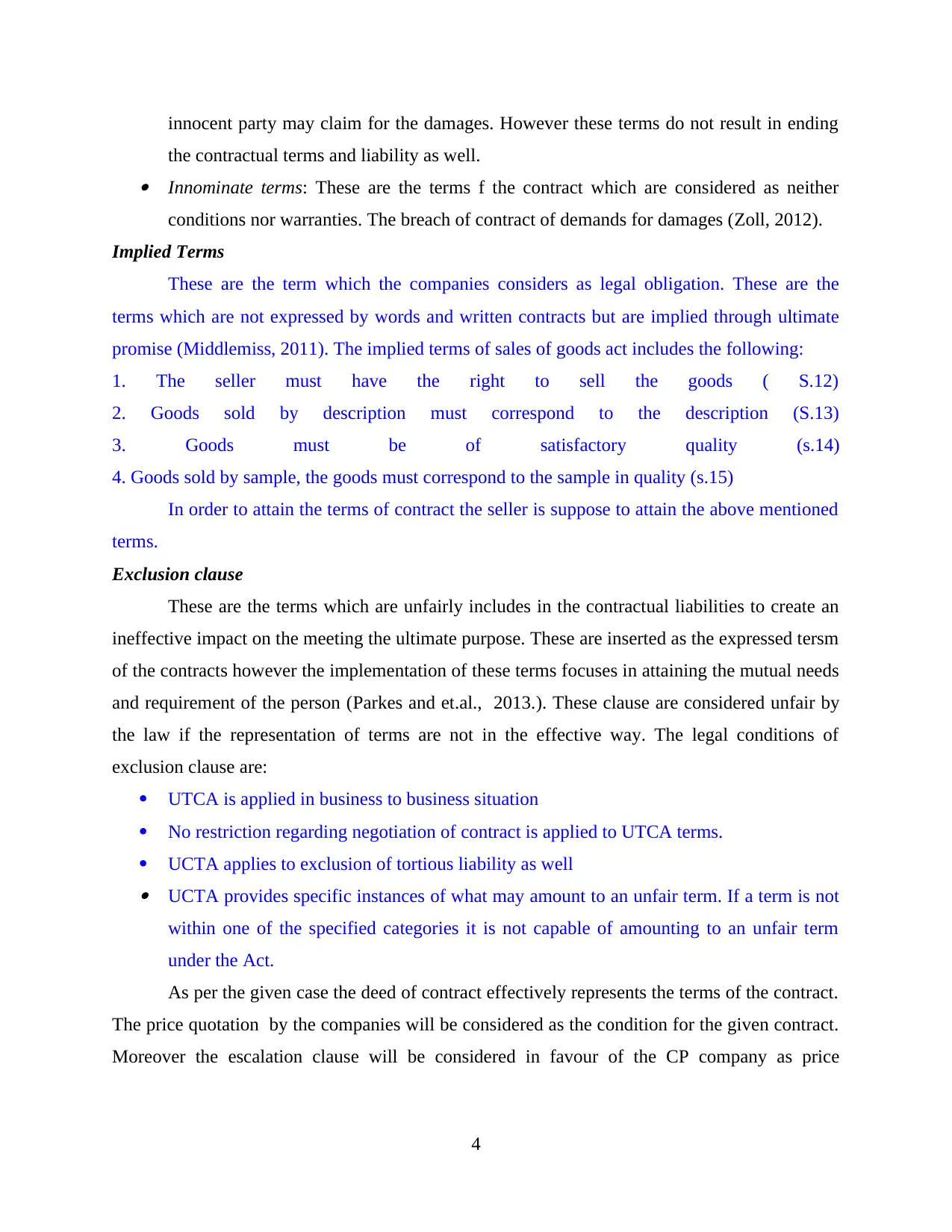
innocent party may claim for the damages. However these terms do not result in ending
the contractual terms and liability as well. Innominate terms: These are the terms f the contract which are considered as neither
conditions nor warranties. The breach of contract of demands for damages (Zoll, 2012).
Implied Terms
These are the term which the companies considers as legal obligation. These are the
terms which are not expressed by words and written contracts but are implied through ultimate
promise (Middlemiss, 2011). The implied terms of sales of goods act includes the following:
1. The seller must have the right to sell the goods ( S.12)
2. Goods sold by description must correspond to the description (S.13)
3. Goods must be of satisfactory quality (s.14)
4. Goods sold by sample, the goods must correspond to the sample in quality (s.15)
In order to attain the terms of contract the seller is suppose to attain the above mentioned
terms.
Exclusion clause
These are the terms which are unfairly includes in the contractual liabilities to create an
ineffective impact on the meeting the ultimate purpose. These are inserted as the expressed tersm
of the contracts however the implementation of these terms focuses in attaining the mutual needs
and requirement of the person (Parkes and et.al., 2013.). These clause are considered unfair by
the law if the representation of terms are not in the effective way. The legal conditions of
exclusion clause are:
UTCA is applied in business to business situation
No restriction regarding negotiation of contract is applied to UTCA terms.
UCTA applies to exclusion of tortious liability as well UCTA provides specific instances of what may amount to an unfair term. If a term is not
within one of the specified categories it is not capable of amounting to an unfair term
under the Act.
As per the given case the deed of contract effectively represents the terms of the contract.
The price quotation by the companies will be considered as the condition for the given contract.
Moreover the escalation clause will be considered in favour of the CP company as price
4
the contractual terms and liability as well. Innominate terms: These are the terms f the contract which are considered as neither
conditions nor warranties. The breach of contract of demands for damages (Zoll, 2012).
Implied Terms
These are the term which the companies considers as legal obligation. These are the
terms which are not expressed by words and written contracts but are implied through ultimate
promise (Middlemiss, 2011). The implied terms of sales of goods act includes the following:
1. The seller must have the right to sell the goods ( S.12)
2. Goods sold by description must correspond to the description (S.13)
3. Goods must be of satisfactory quality (s.14)
4. Goods sold by sample, the goods must correspond to the sample in quality (s.15)
In order to attain the terms of contract the seller is suppose to attain the above mentioned
terms.
Exclusion clause
These are the terms which are unfairly includes in the contractual liabilities to create an
ineffective impact on the meeting the ultimate purpose. These are inserted as the expressed tersm
of the contracts however the implementation of these terms focuses in attaining the mutual needs
and requirement of the person (Parkes and et.al., 2013.). These clause are considered unfair by
the law if the representation of terms are not in the effective way. The legal conditions of
exclusion clause are:
UTCA is applied in business to business situation
No restriction regarding negotiation of contract is applied to UTCA terms.
UCTA applies to exclusion of tortious liability as well UCTA provides specific instances of what may amount to an unfair term. If a term is not
within one of the specified categories it is not capable of amounting to an unfair term
under the Act.
As per the given case the deed of contract effectively represents the terms of the contract.
The price quotation by the companies will be considered as the condition for the given contract.
Moreover the escalation clause will be considered in favour of the CP company as price
4
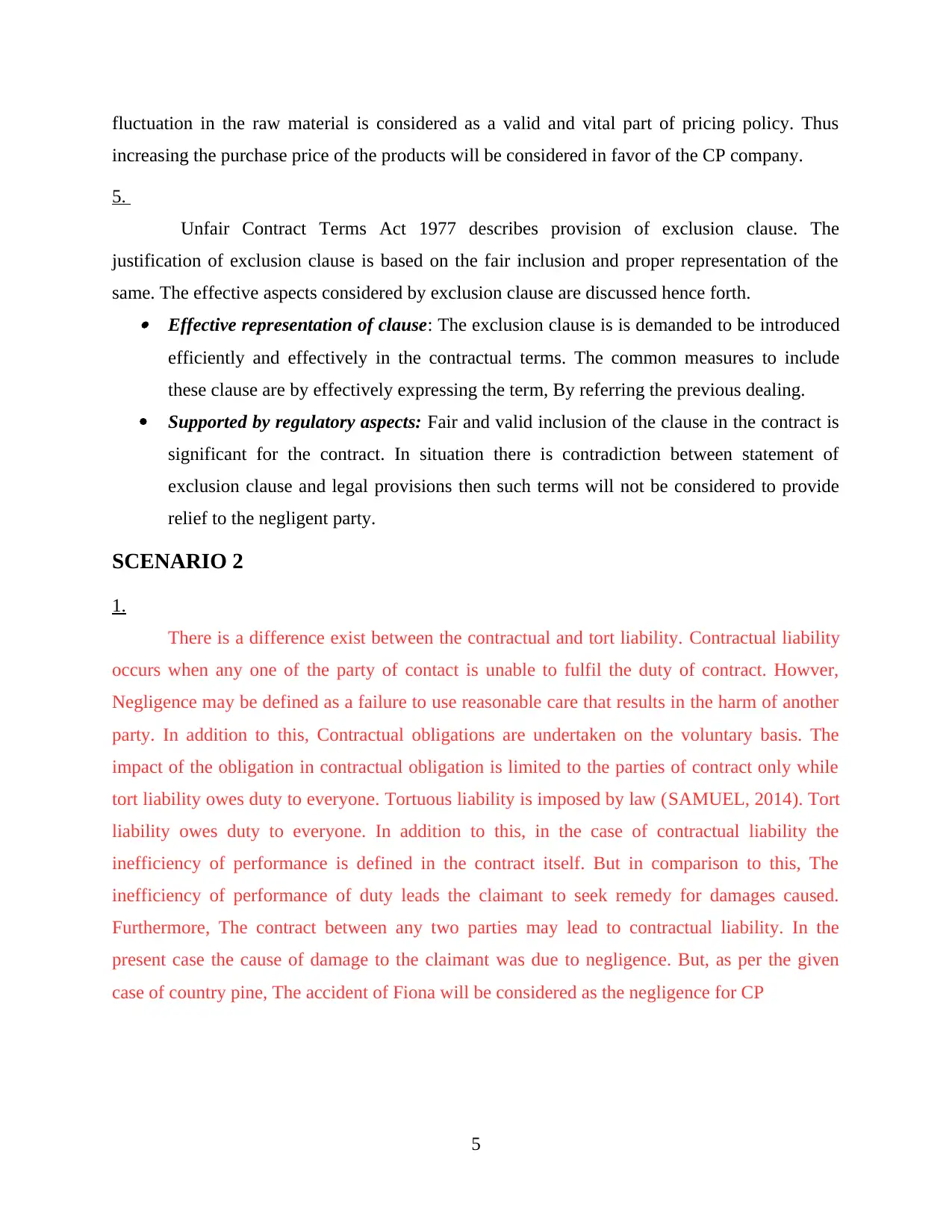
fluctuation in the raw material is considered as a valid and vital part of pricing policy. Thus
increasing the purchase price of the products will be considered in favor of the CP company.
5.
Unfair Contract Terms Act 1977 describes provision of exclusion clause. The
justification of exclusion clause is based on the fair inclusion and proper representation of the
same. The effective aspects considered by exclusion clause are discussed hence forth. Effective representation of clause: The exclusion clause is is demanded to be introduced
efficiently and effectively in the contractual terms. The common measures to include
these clause are by effectively expressing the term, By referring the previous dealing.
Supported by regulatory aspects: Fair and valid inclusion of the clause in the contract is
significant for the contract. In situation there is contradiction between statement of
exclusion clause and legal provisions then such terms will not be considered to provide
relief to the negligent party.
SCENARIO 2
1.
There is a difference exist between the contractual and tort liability. Contractual liability
occurs when any one of the party of contact is unable to fulfil the duty of contract. Howver,
Negligence may be defined as a failure to use reasonable care that results in the harm of another
party. In addition to this, Contractual obligations are undertaken on the voluntary basis. The
impact of the obligation in contractual obligation is limited to the parties of contract only while
tort liability owes duty to everyone. Tortuous liability is imposed by law (SAMUEL, 2014). Tort
liability owes duty to everyone. In addition to this, in the case of contractual liability the
inefficiency of performance is defined in the contract itself. But in comparison to this, The
inefficiency of performance of duty leads the claimant to seek remedy for damages caused.
Furthermore, The contract between any two parties may lead to contractual liability. In the
present case the cause of damage to the claimant was due to negligence. But, as per the given
case of country pine, The accident of Fiona will be considered as the negligence for CP
5
increasing the purchase price of the products will be considered in favor of the CP company.
5.
Unfair Contract Terms Act 1977 describes provision of exclusion clause. The
justification of exclusion clause is based on the fair inclusion and proper representation of the
same. The effective aspects considered by exclusion clause are discussed hence forth. Effective representation of clause: The exclusion clause is is demanded to be introduced
efficiently and effectively in the contractual terms. The common measures to include
these clause are by effectively expressing the term, By referring the previous dealing.
Supported by regulatory aspects: Fair and valid inclusion of the clause in the contract is
significant for the contract. In situation there is contradiction between statement of
exclusion clause and legal provisions then such terms will not be considered to provide
relief to the negligent party.
SCENARIO 2
1.
There is a difference exist between the contractual and tort liability. Contractual liability
occurs when any one of the party of contact is unable to fulfil the duty of contract. Howver,
Negligence may be defined as a failure to use reasonable care that results in the harm of another
party. In addition to this, Contractual obligations are undertaken on the voluntary basis. The
impact of the obligation in contractual obligation is limited to the parties of contract only while
tort liability owes duty to everyone. Tortuous liability is imposed by law (SAMUEL, 2014). Tort
liability owes duty to everyone. In addition to this, in the case of contractual liability the
inefficiency of performance is defined in the contract itself. But in comparison to this, The
inefficiency of performance of duty leads the claimant to seek remedy for damages caused.
Furthermore, The contract between any two parties may lead to contractual liability. In the
present case the cause of damage to the claimant was due to negligence. But, as per the given
case of country pine, The accident of Fiona will be considered as the negligence for CP
5
Paraphrase This Document
Need a fresh take? Get an instant paraphrase of this document with our AI Paraphraser
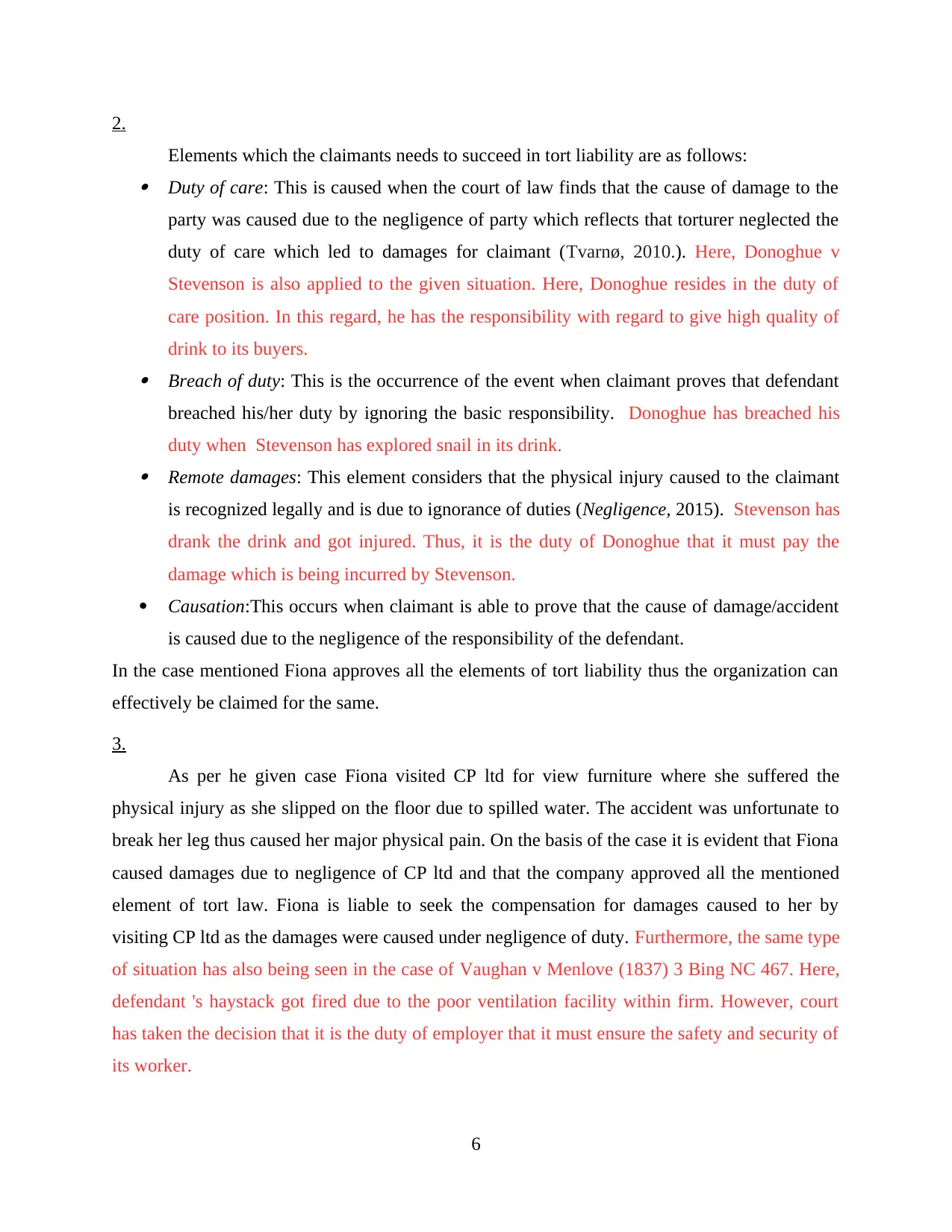
2.
Elements which the claimants needs to succeed in tort liability are as follows: Duty of care: This is caused when the court of law finds that the cause of damage to the
party was caused due to the negligence of party which reflects that torturer neglected the
duty of care which led to damages for claimant (Tvarnø, 2010.). Here, Donoghue v
Stevenson is also applied to the given situation. Here, Donoghue resides in the duty of
care position. In this regard, he has the responsibility with regard to give high quality of
drink to its buyers. Breach of duty: This is the occurrence of the event when claimant proves that defendant
breached his/her duty by ignoring the basic responsibility. Donoghue has breached his
duty when Stevenson has explored snail in its drink. Remote damages: This element considers that the physical injury caused to the claimant
is recognized legally and is due to ignorance of duties (Negligence, 2015). Stevenson has
drank the drink and got injured. Thus, it is the duty of Donoghue that it must pay the
damage which is being incurred by Stevenson.
Causation:This occurs when claimant is able to prove that the cause of damage/accident
is caused due to the negligence of the responsibility of the defendant.
In the case mentioned Fiona approves all the elements of tort liability thus the organization can
effectively be claimed for the same.
3.
As per he given case Fiona visited CP ltd for view furniture where she suffered the
physical injury as she slipped on the floor due to spilled water. The accident was unfortunate to
break her leg thus caused her major physical pain. On the basis of the case it is evident that Fiona
caused damages due to negligence of CP ltd and that the company approved all the mentioned
element of tort law. Fiona is liable to seek the compensation for damages caused to her by
visiting CP ltd as the damages were caused under negligence of duty. Furthermore, the same type
of situation has also being seen in the case of Vaughan v Menlove (1837) 3 Bing NC 467. Here,
defendant 's haystack got fired due to the poor ventilation facility within firm. However, court
has taken the decision that it is the duty of employer that it must ensure the safety and security of
its worker.
6
Elements which the claimants needs to succeed in tort liability are as follows: Duty of care: This is caused when the court of law finds that the cause of damage to the
party was caused due to the negligence of party which reflects that torturer neglected the
duty of care which led to damages for claimant (Tvarnø, 2010.). Here, Donoghue v
Stevenson is also applied to the given situation. Here, Donoghue resides in the duty of
care position. In this regard, he has the responsibility with regard to give high quality of
drink to its buyers. Breach of duty: This is the occurrence of the event when claimant proves that defendant
breached his/her duty by ignoring the basic responsibility. Donoghue has breached his
duty when Stevenson has explored snail in its drink. Remote damages: This element considers that the physical injury caused to the claimant
is recognized legally and is due to ignorance of duties (Negligence, 2015). Stevenson has
drank the drink and got injured. Thus, it is the duty of Donoghue that it must pay the
damage which is being incurred by Stevenson.
Causation:This occurs when claimant is able to prove that the cause of damage/accident
is caused due to the negligence of the responsibility of the defendant.
In the case mentioned Fiona approves all the elements of tort liability thus the organization can
effectively be claimed for the same.
3.
As per he given case Fiona visited CP ltd for view furniture where she suffered the
physical injury as she slipped on the floor due to spilled water. The accident was unfortunate to
break her leg thus caused her major physical pain. On the basis of the case it is evident that Fiona
caused damages due to negligence of CP ltd and that the company approved all the mentioned
element of tort law. Fiona is liable to seek the compensation for damages caused to her by
visiting CP ltd as the damages were caused under negligence of duty. Furthermore, the same type
of situation has also being seen in the case of Vaughan v Menlove (1837) 3 Bing NC 467. Here,
defendant 's haystack got fired due to the poor ventilation facility within firm. However, court
has taken the decision that it is the duty of employer that it must ensure the safety and security of
its worker.
6
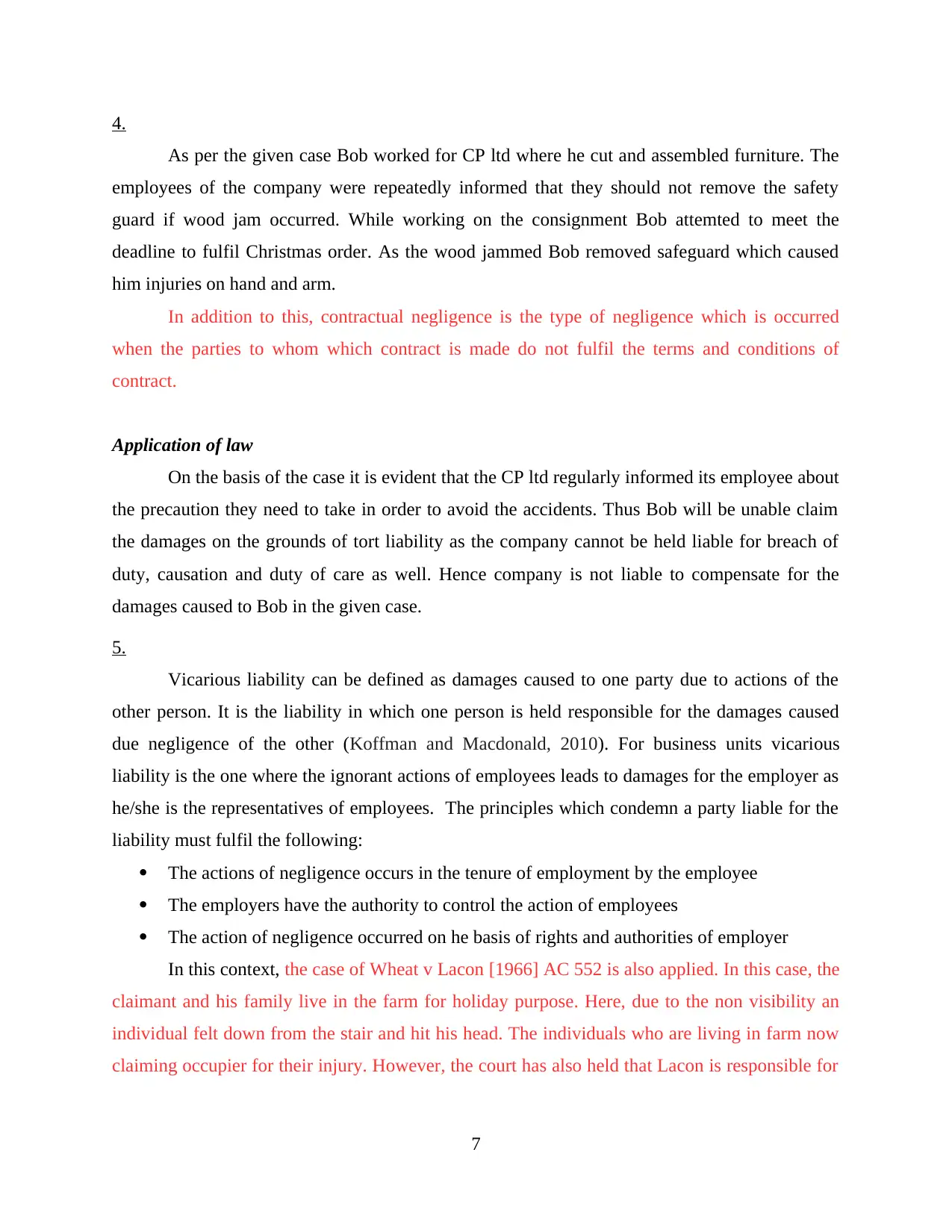
4.
As per the given case Bob worked for CP ltd where he cut and assembled furniture. The
employees of the company were repeatedly informed that they should not remove the safety
guard if wood jam occurred. While working on the consignment Bob attemted to meet the
deadline to fulfil Christmas order. As the wood jammed Bob removed safeguard which caused
him injuries on hand and arm.
In addition to this, contractual negligence is the type of negligence which is occurred
when the parties to whom which contract is made do not fulfil the terms and conditions of
contract.
Application of law
On the basis of the case it is evident that the CP ltd regularly informed its employee about
the precaution they need to take in order to avoid the accidents. Thus Bob will be unable claim
the damages on the grounds of tort liability as the company cannot be held liable for breach of
duty, causation and duty of care as well. Hence company is not liable to compensate for the
damages caused to Bob in the given case.
5.
Vicarious liability can be defined as damages caused to one party due to actions of the
other person. It is the liability in which one person is held responsible for the damages caused
due negligence of the other (Koffman and Macdonald, 2010). For business units vicarious
liability is the one where the ignorant actions of employees leads to damages for the employer as
he/she is the representatives of employees. The principles which condemn a party liable for the
liability must fulfil the following:
The actions of negligence occurs in the tenure of employment by the employee
The employers have the authority to control the action of employees
The action of negligence occurred on he basis of rights and authorities of employer
In this context, the case of Wheat v Lacon [1966] AC 552 is also applied. In this case, the
claimant and his family live in the farm for holiday purpose. Here, due to the non visibility an
individual felt down from the stair and hit his head. The individuals who are living in farm now
claiming occupier for their injury. However, the court has also held that Lacon is responsible for
7
As per the given case Bob worked for CP ltd where he cut and assembled furniture. The
employees of the company were repeatedly informed that they should not remove the safety
guard if wood jam occurred. While working on the consignment Bob attemted to meet the
deadline to fulfil Christmas order. As the wood jammed Bob removed safeguard which caused
him injuries on hand and arm.
In addition to this, contractual negligence is the type of negligence which is occurred
when the parties to whom which contract is made do not fulfil the terms and conditions of
contract.
Application of law
On the basis of the case it is evident that the CP ltd regularly informed its employee about
the precaution they need to take in order to avoid the accidents. Thus Bob will be unable claim
the damages on the grounds of tort liability as the company cannot be held liable for breach of
duty, causation and duty of care as well. Hence company is not liable to compensate for the
damages caused to Bob in the given case.
5.
Vicarious liability can be defined as damages caused to one party due to actions of the
other person. It is the liability in which one person is held responsible for the damages caused
due negligence of the other (Koffman and Macdonald, 2010). For business units vicarious
liability is the one where the ignorant actions of employees leads to damages for the employer as
he/she is the representatives of employees. The principles which condemn a party liable for the
liability must fulfil the following:
The actions of negligence occurs in the tenure of employment by the employee
The employers have the authority to control the action of employees
The action of negligence occurred on he basis of rights and authorities of employer
In this context, the case of Wheat v Lacon [1966] AC 552 is also applied. In this case, the
claimant and his family live in the farm for holiday purpose. Here, due to the non visibility an
individual felt down from the stair and hit his head. The individuals who are living in farm now
claiming occupier for their injury. However, the court has also held that Lacon is responsible for
7
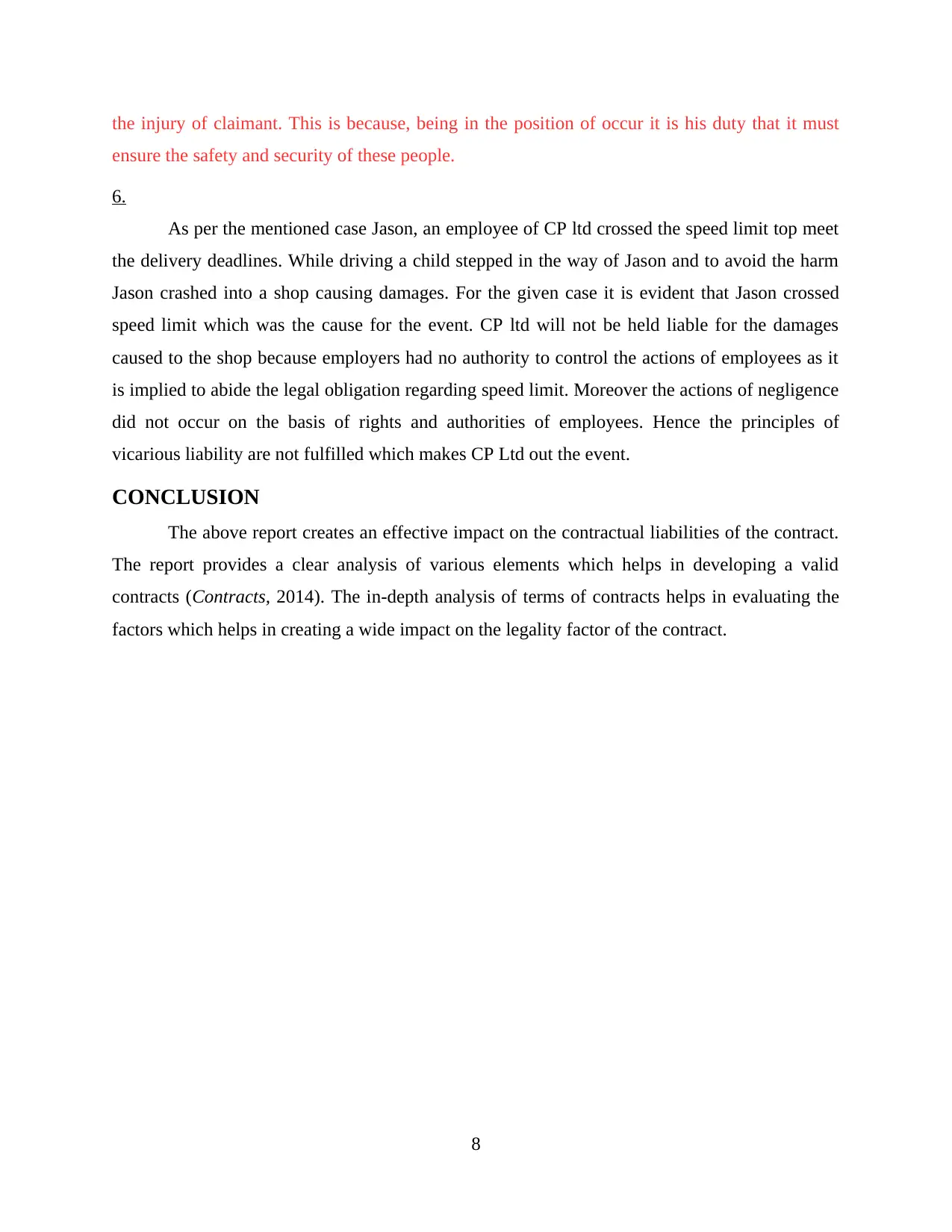
the injury of claimant. This is because, being in the position of occur it is his duty that it must
ensure the safety and security of these people.
6.
As per the mentioned case Jason, an employee of CP ltd crossed the speed limit top meet
the delivery deadlines. While driving a child stepped in the way of Jason and to avoid the harm
Jason crashed into a shop causing damages. For the given case it is evident that Jason crossed
speed limit which was the cause for the event. CP ltd will not be held liable for the damages
caused to the shop because employers had no authority to control the actions of employees as it
is implied to abide the legal obligation regarding speed limit. Moreover the actions of negligence
did not occur on the basis of rights and authorities of employees. Hence the principles of
vicarious liability are not fulfilled which makes CP Ltd out the event.
CONCLUSION
The above report creates an effective impact on the contractual liabilities of the contract.
The report provides a clear analysis of various elements which helps in developing a valid
contracts (Contracts, 2014). The in-depth analysis of terms of contracts helps in evaluating the
factors which helps in creating a wide impact on the legality factor of the contract.
8
ensure the safety and security of these people.
6.
As per the mentioned case Jason, an employee of CP ltd crossed the speed limit top meet
the delivery deadlines. While driving a child stepped in the way of Jason and to avoid the harm
Jason crashed into a shop causing damages. For the given case it is evident that Jason crossed
speed limit which was the cause for the event. CP ltd will not be held liable for the damages
caused to the shop because employers had no authority to control the actions of employees as it
is implied to abide the legal obligation regarding speed limit. Moreover the actions of negligence
did not occur on the basis of rights and authorities of employees. Hence the principles of
vicarious liability are not fulfilled which makes CP Ltd out the event.
CONCLUSION
The above report creates an effective impact on the contractual liabilities of the contract.
The report provides a clear analysis of various elements which helps in developing a valid
contracts (Contracts, 2014). The in-depth analysis of terms of contracts helps in evaluating the
factors which helps in creating a wide impact on the legality factor of the contract.
8
Secure Best Marks with AI Grader
Need help grading? Try our AI Grader for instant feedback on your assignments.
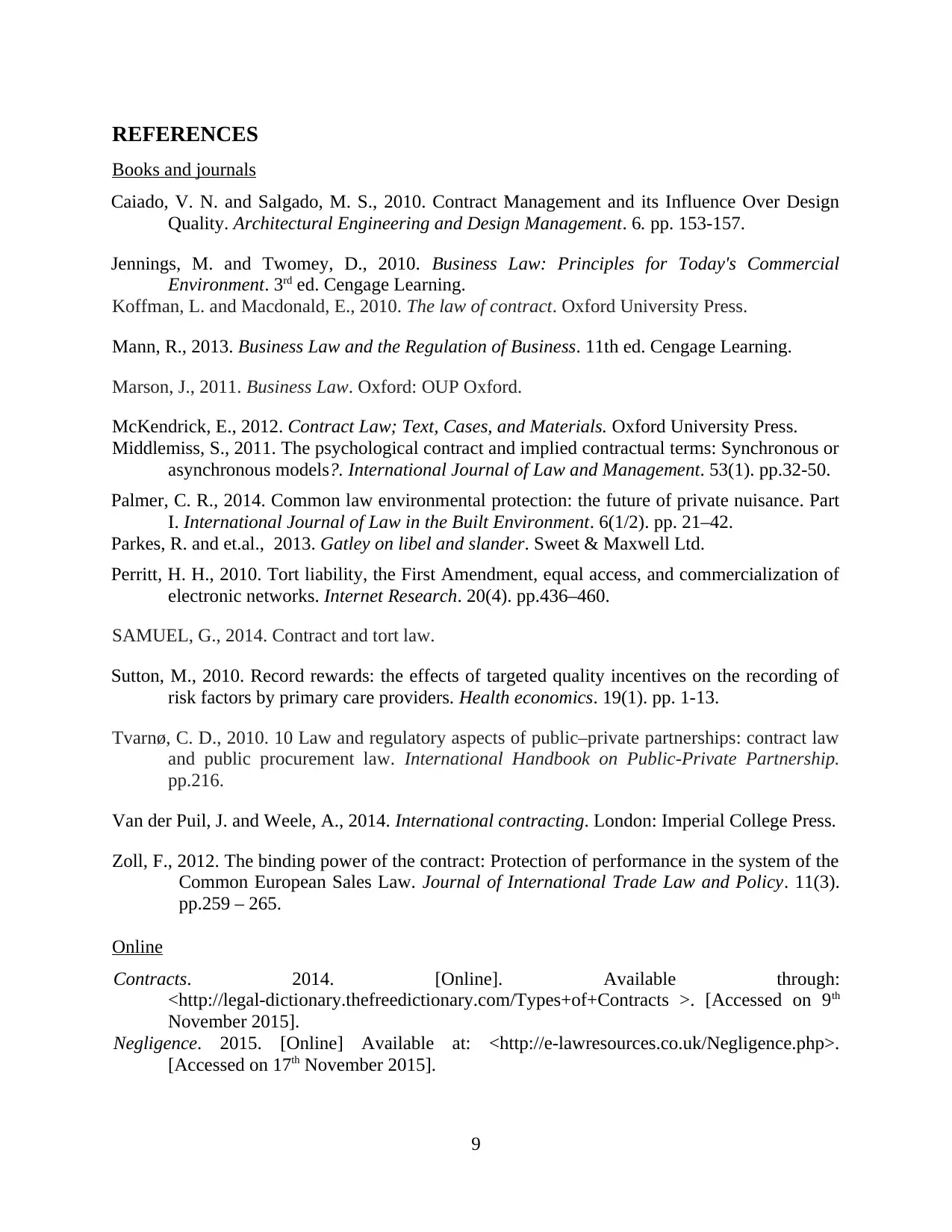
REFERENCES
Books and journals
Caiado, V. N. and Salgado, M. S., 2010. Contract Management and its Influence Over Design
Quality. Architectural Engineering and Design Management. 6. pp. 153-157.
Jennings, M. and Twomey, D., 2010. Business Law: Principles for Today's Commercial
Environment. 3rd ed. Cengage Learning.
Koffman, L. and Macdonald, E., 2010. The law of contract. Oxford University Press.
Mann, R., 2013. Business Law and the Regulation of Business. 11th ed. Cengage Learning.
Marson, J., 2011. Business Law. Oxford: OUP Oxford.
McKendrick, E., 2012. Contract Law; Text, Cases, and Materials. Oxford University Press.
Middlemiss, S., 2011. The psychological contract and implied contractual terms: Synchronous or
asynchronous models?. International Journal of Law and Management. 53(1). pp.32-50.
Palmer, C. R., 2014. Common law environmental protection: the future of private nuisance. Part
I. International Journal of Law in the Built Environment. 6(1/2). pp. 21–42.
Parkes, R. and et.al., 2013. Gatley on libel and slander. Sweet & Maxwell Ltd.
Perritt, H. H., 2010. Tort liability, the First Amendment, equal access, and commercialization of
electronic networks. Internet Research. 20(4). pp.436–460.
SAMUEL, G., 2014. Contract and tort law.
Sutton, M., 2010. Record rewards: the effects of targeted quality incentives on the recording of
risk factors by primary care providers. Health economics. 19(1). pp. 1-13.
Tvarnø, C. D., 2010. 10 Law and regulatory aspects of public–private partnerships: contract law
and public procurement law. International Handbook on Public-Private Partnership.
pp.216.
Van der Puil, J. and Weele, A., 2014. International contracting. London: Imperial College Press.
Zoll, F., 2012. The binding power of the contract: Protection of performance in the system of the
Common European Sales Law. Journal of International Trade Law and Policy. 11(3).
pp.259 – 265.
Online
Contracts. 2014. [Online]. Available through:
<http://legal-dictionary.thefreedictionary.com/Types+of+Contracts >. [Accessed on 9th
November 2015].
Negligence. 2015. [Online] Available at: <http://e-lawresources.co.uk/Negligence.php>.
[Accessed on 17th November 2015].
9
Books and journals
Caiado, V. N. and Salgado, M. S., 2010. Contract Management and its Influence Over Design
Quality. Architectural Engineering and Design Management. 6. pp. 153-157.
Jennings, M. and Twomey, D., 2010. Business Law: Principles for Today's Commercial
Environment. 3rd ed. Cengage Learning.
Koffman, L. and Macdonald, E., 2010. The law of contract. Oxford University Press.
Mann, R., 2013. Business Law and the Regulation of Business. 11th ed. Cengage Learning.
Marson, J., 2011. Business Law. Oxford: OUP Oxford.
McKendrick, E., 2012. Contract Law; Text, Cases, and Materials. Oxford University Press.
Middlemiss, S., 2011. The psychological contract and implied contractual terms: Synchronous or
asynchronous models?. International Journal of Law and Management. 53(1). pp.32-50.
Palmer, C. R., 2014. Common law environmental protection: the future of private nuisance. Part
I. International Journal of Law in the Built Environment. 6(1/2). pp. 21–42.
Parkes, R. and et.al., 2013. Gatley on libel and slander. Sweet & Maxwell Ltd.
Perritt, H. H., 2010. Tort liability, the First Amendment, equal access, and commercialization of
electronic networks. Internet Research. 20(4). pp.436–460.
SAMUEL, G., 2014. Contract and tort law.
Sutton, M., 2010. Record rewards: the effects of targeted quality incentives on the recording of
risk factors by primary care providers. Health economics. 19(1). pp. 1-13.
Tvarnø, C. D., 2010. 10 Law and regulatory aspects of public–private partnerships: contract law
and public procurement law. International Handbook on Public-Private Partnership.
pp.216.
Van der Puil, J. and Weele, A., 2014. International contracting. London: Imperial College Press.
Zoll, F., 2012. The binding power of the contract: Protection of performance in the system of the
Common European Sales Law. Journal of International Trade Law and Policy. 11(3).
pp.259 – 265.
Online
Contracts. 2014. [Online]. Available through:
<http://legal-dictionary.thefreedictionary.com/Types+of+Contracts >. [Accessed on 9th
November 2015].
Negligence. 2015. [Online] Available at: <http://e-lawresources.co.uk/Negligence.php>.
[Accessed on 17th November 2015].
9
1 out of 11
Related Documents
Your All-in-One AI-Powered Toolkit for Academic Success.
+13062052269
info@desklib.com
Available 24*7 on WhatsApp / Email
![[object Object]](/_next/static/media/star-bottom.7253800d.svg)
Unlock your academic potential
© 2024 | Zucol Services PVT LTD | All rights reserved.





